Related Research Articles

The John Kilpatrick Turnpike is a toll road in Oklahoma City, Oklahoma. The turnpike forms a partial loop that runs from State Highway 152 (SH-152) in the west to an interchange with Interstate 35 (I-35) and I-44 in the east. At the eastern terminus, traffic continuing east merges with I-44 traffic, forming the Turner Turnpike. The Kilpatrick Turnpike is 29.4 miles (47.3 km) long.

The Turner Turnpike is a toll road in central Oklahoma, connecting its two largest cities, Oklahoma City and Tulsa. Authorized by the Oklahoma Legislature in 1947 and opened in May 1953, it is the oldest of the state's eleven turnpikes. The route is signed as Interstate 44 for its entire length, but was constructed prior to its designation as such. The Turner Turnpike was named after Governor Roy J. Turner, who pushed for efforts to build this toll road to connect the state's two largest cities.
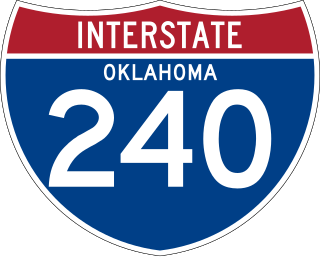
Interstate 240 (I-240) is an Interstate Highway in Oklahoma, United States, that runs 16.22 miles (26.10 km) west from I-40 to I-44 in southern Oklahoma City. After its terminus in southwest Oklahoma City, the main I-240 roadbed becomes I-44 and Airport Road toward Will Rogers World Airport. The Interstate overlaps State Highway 3 (SH-3), the longest Oklahoma state highway, for its entire length.
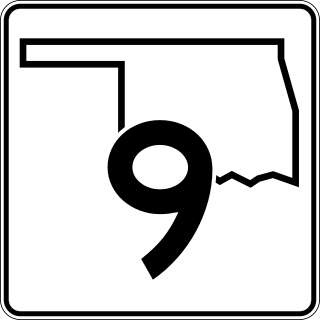
State Highway 9, abbreviated as SH-9, OK-9, or simply Highway 9, is a major east–west highway in the U.S. state of Oklahoma. Spanning across the central part of the state, SH-9 begins at the Texas state line near Madge, Oklahoma, and ends at the Arkansas state line near Fort Smith, Arkansas. State Highway 9 is a major highway around the Norman area. At 348.1 miles (560.2 km), SH-9 is Oklahoma's second-longest state highway.

State Highway 7 is a 150.5-mile (242.2 km) highway in southern Oklahoma. This lengthy highway connects many towns in Oklahoma's "Little Dixie" area. It runs from Interstate 44 in Lawton to U.S. 69/US-75 in Atoka.

State Highway 99, abbreviated SH-99, is a north–south state highway through central Oklahoma. It runs from the Texas border at Lake Texoma to the Kansas border near Lake Hulah. It is 241.5 miles (388.7 km) long. The highway overlaps US-377 for over half its length.

The Oklahoma City Police Department (OCPD), was established in 1889 following the Land Run. The OCPD is the largest law enforcement agency in the State of Oklahoma and has primary police jurisdiction within the corporate limits of the City of Oklahoma City. The OCPD is one of the oldest police departments in Oklahoma, tracing its roots back to Indian Territory.

The Oklahoma Department of Transportation (ODOT) is an agency of the government of Oklahoma responsible for the construction and maintenance of the state's transportation infrastructure. Under the leadership of the Oklahoma secretary of transportation and ODOT executive director, the department maintains public infrastructure that includes highways and state-owned railroads and administers programs for county roads, city streets, public transit, passenger rail, waterways and active transportation. Along with the Oklahoma Turnpike Authority, the department is the primary infrastructure construction and maintenance agency of the State.

The H. E. Bailey Turnpike is an 86.4-mile (139.0 km) toll road in the southwestern region of the U.S. state of Oklahoma. The route, opened on April 23, 1964, is a four-lane limited access highway that connects Oklahoma City to Lawton in its northern section and Lawton to Wichita Falls along its southern section, roughly paralleling U.S. Route 277. The turnpike also includes an 8.2-mile (13.2 km) spur route that leads toward Norman, Oklahoma. Since 1982, it has been signed as a part of Interstate 44, and as such uses its mileposts. Travel along the full length of the toll road costs $5.50 for a two-axle vehicle.

The Chickasaw Turnpike, also designated State Highway 301 (SH-301), is a short toll road in the rural south central region of the U.S. state of Oklahoma. A two-lane freeway, it stretches for 13.3 miles (21.4 km) from north of Sulphur to just south of Ada. The Oklahoma Turnpike Authority (OTA) owns, maintains, and collects tolls on the turnpike. The first section of the Chickasaw Turnpike opened on September 1, 1991.

The Creek Turnpike, also designated State Highway 364 (SH-364), is a 33.22-mile-long (53.46 km) freeway-standard toll road that lies entirely in the U.S. state of Oklahoma. The turnpike forms a partial beltway around the south and east sides of Tulsa, Oklahoma's second largest city. The Creek Turnpike's western terminus is at the Turner Turnpike in Sapulpa, while its northeastern terminus is at the Will Rogers Turnpike in Fair Oaks; both ends of the Creek Turnpike connect with Interstate 44 (I-44). Along the way, the highway passes through the cities of Sapulpa, Jenks, Tulsa, and Broken Arrow, and the counties of Creek, Tulsa, Wagoner and Rogers. The road is maintained by the Oklahoma Turnpike Authority (OTA), except for a brief free section shared with U.S. Route 64 (US-64) and US-169. This free section is maintained by the Oklahoma Department of Transportation (ODOT).
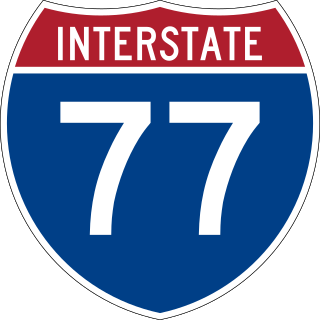
Interstate 77 (I-77) in Ohio is an Interstate Highway that runs for 163.03 miles (262.37 km) through the state. The highway crosses into Ohio on the Marietta–Williamstown Interstate Bridge over the Ohio River near Marietta. The northern terminus is in Cleveland at the junction with I-90.
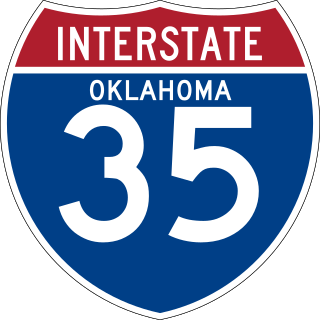
Interstate 35 (I-35), in the US State of Oklahoma, runs from the Red River at the Texas border to the Kansas state line near Braman for a length of 236 miles (380 km). I-35 has one spur route in the state, I-235 in the inner city of Oklahoma City.

Interstate 44 (I-44) runs diagonally through the US state of Oklahoma, spanning from the Texas state line near Wichita Falls, Texas, to the Missouri border near Joplin, Missouri. It connects three of Oklahoma's largest cities: Oklahoma City, Tulsa, and Lawton. Most of I-44 in Oklahoma is a toll road. In southwestern Oklahoma, I-44 is the H. E. Bailey Turnpike and follows a north–south direction. From Oklahoma City to Tulsa, I-44 follows the Turner Turnpike. As I-44 leaves Tulsa, it becomes the Will Rogers Turnpike to the Missouri border. In the Lawton, Oklahoma City, and Tulsa metro areas, I-44 is toll-free.

Interstate 75 (I-75) runs from Cincinnati to Toledo by way of Dayton in the US state of Ohio. The highway enters the state running concurrently with I-71 from Kentucky on the Brent Spence Bridge over the Ohio River and into the Bluegrass region. I-75 continues along the Mill Creek Expressway northward to the Butler County line just north of I-275. From there, the freeway runs into the Miami Valley and then passes through the Great Black Swamp before crossing into Michigan.

Oklahoma has an extensive turnpike system, maintained by the state government through the Oklahoma Turnpike Authority. All of Oklahoma's turnpikes are controlled-access highways. The majority have at least four lanes, though the Chickasaw Turnpike is two lanes.

U.S. Route 412 is a U.S. highway in the south-central portion of the United States, connecting Springer, New Mexico to Columbia, Tennessee. A 504.11-mile (811.29 km) section of the highway crosses the state of Oklahoma, traversing the state from west to east. Entering the state southwest of Boise City, US-412 runs the length of the Oklahoma Panhandle and serves the northern portion of the state's main body, before leaving the state at West Siloam Springs. Along the way, the route serves many notable cities and towns, including Boise City, Guymon, Woodward, Enid, and the state's second-largest city, Tulsa.

The Oklahoma secretary of transportation is a member of the Oklahoma Governor's Cabinet. The secretary is appointed by the governor, with the consent of the Oklahoma Senate, to serve at the pleasure of the governor. The secretary serves as the chief advisor to the governor on land, water, air and space traffic transportation needs and infrastructure.
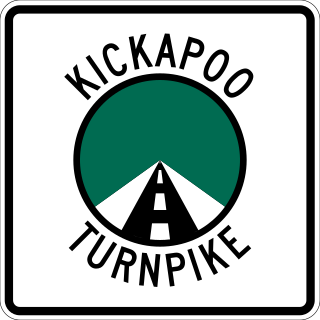
The Kickapoo Turnpike is a 21-mile (34 km) toll road in the U.S. state of Oklahoma. The northern section from US-62 to Interstate 44 opened to traffic on October 13, 2020. The southern segment from Interstate 40 to US-62 opened to traffic on January 5, 2021.
References
- ↑ Staff (October 26, 1976). "Death Takes H.E. Bailey". The Daily Oklahoman. pp. 1, 20 . Retrieved April 7, 2021– via Newspapers.com.
- ↑ "January Moments in History: ODOT 100 Years". Oklahoma Department of Transportation . Retrieved September 23, 2011.
- 1 2 3 "City Manager". City of Oklahoma City. Archived from the original on November 1, 2011. Retrieved September 23, 2011.
- 1 2 "February Moments in History: ODOT 100 Years". Oklahoma Department of Transportation . Retrieved September 23, 2011.
- ↑ Owens, Ron (1995). Oklahoma Justice: A Century of Gunfighers, Gangsters, and Terrorists. Turner Publishing Company. pp. 139–140.
- ↑ "March Moments in History: ODOT 100 Years". Oklahoma Department of Transportation . Retrieved September 23, 2011.